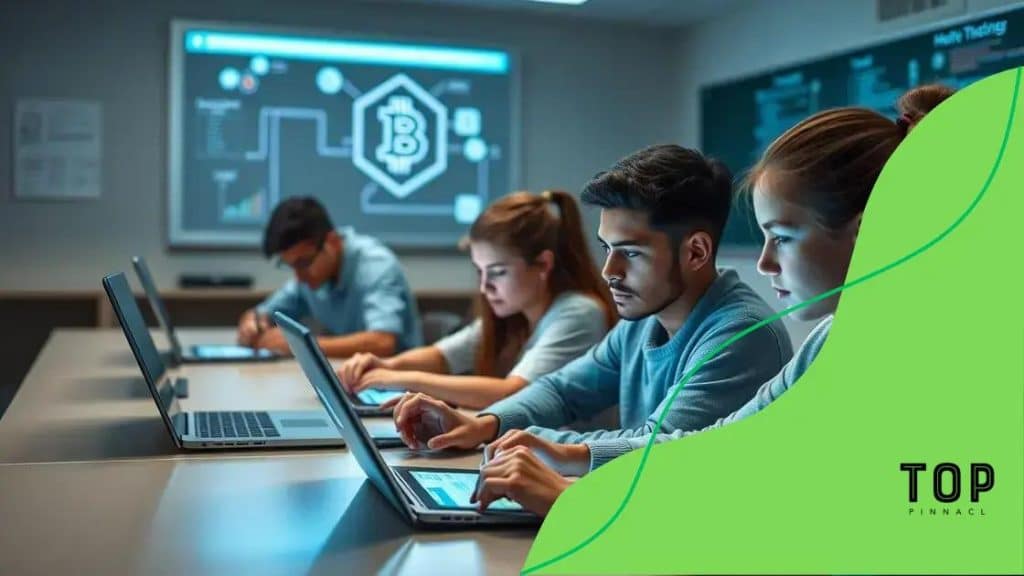Blockchain student records: revolutionizing education

Blockchain technology enhances security and efficiency in education by providing tamper-proof student records, giving students control over their data, and streamlining administrative processes.
Blockchain student records are changing the way educational achievements are documented and verified. Have you ever wondered how this system can benefit students and institutions alike? Let’s dive into the potential of this innovative approach.
Understanding blockchain technology
Understanding blockchain technology is essential for grasping its impact on various sectors, including education. This innovative technology serves as a public ledger, ensuring secure and transparent transactions between parties.
At its core, blockchain consists of a chain of blocks that store information. Each block contains a specific number of transactions which are linked to previous blocks. This linkage creates a secure chain, making it difficult to alter any data once it has been recorded. But how does this apply to student records?
Key Features of Blockchain
Several features make blockchain an appealing choice for managing student records.
- Decentralization: Unlike traditional systems, blockchain does not rely on a central authority, reducing the risk of data tampering.
- Transparency: All parties have access to view transactions, fostering trust among stakeholders.
- Security: Cryptography ensures that the information is protected from unauthorized access.
- Immutability: Once data is added to the blockchain, it cannot be changed, ensuring the history remains intact.
When implemented in education, blockchain can revolutionize the way institutions verify student achievements. Imagine fast, secure, and tamper-proof access to a student’s academic history. This not only saves time but also enhances the credibility of educational credentials.
As more educational institutions explore blockchain technology, we can anticipate a future where student records are easily accessible and securely stored. This technology empowers students, making it simpler for them to showcase their achievements without the hassle of traditional methods.
While challenges remain, the potential benefits of blockchain for educational institutions are immeasurable. From administrative efficiency to increased trust, understanding blockchain technology is just the first step towards embracing its numerous advantages in the education sector.
The advantages of blockchain in student records
The advantages of blockchain in student records are increasingly recognized in the education sector. By utilizing this technology, schools and universities can manage and verify academic achievements more effectively.
One significant benefit is the increase in security. With blockchain, student data is encrypted and stored across a distributed network. This makes unauthorized access and data manipulation nearly impossible. Each record is part of a secure chain, ensuring that once information is added, it remains unchanged.
Enhanced Transparency
Another advantage is the transparency that blockchain provides. Since all transactions are recorded in a public ledger, students and institutions can view their records at any time. This transparency builds trust among stakeholders, including students, employers, and educational institutions.
- Easy access: Students can quickly access their academic records without lengthy verification processes.
- Fight against fraud: Since records can’t be altered retroactively, it becomes much harder for individuals to falsify qualifications.
- Streamlined processes: Institutions can automate verification processes, saving time and resources.
- Global recognition: Blockchain allows for standardized records that can be universally recognized, simplifying international education.
Furthermore, the blockchain minimizes administrative burdens. By automating processes, schools can allocate their resources more efficiently, focusing on improving education rather than managing records. This shift also helps reduce costs associated with traditional record-keeping systems.
In conclusion, as blockchain technology continues to evolve, its potential to revolutionize how we manage and verify student records becomes ever clearer. The advantages it offers pave the way for a more secure, transparent, and efficient educational system.
How blockchain enhances security in education

How blockchain enhances security in education is a crucial topic in today’s digital landscape. With increasing concerns about data breaches and privacy, utilizing blockchain technology offers a robust solution for educational institutions.
One of the leading features of blockchain is its decentralized nature. Unlike traditional databases that store data in a single location, blockchain distributes data across a network of computers. This decentralization protects sensitive information from unauthorized access and cyberattacks.
Encryption and Data Integrity
Each transaction on the blockchain is encrypted, ensuring that only authorized users can access the data. This level of encryption creates a secure environment for managing student records, grades, and personal information. Once data is entered into the blockchain, it becomes nearly impossible to alter without the consensus of the network, maintaining data integrity.
- Immutability: Changes to records are recorded as new entries rather than altering existing ones, ensuring a clear history.
- Access controls: Schools can set permission levels, allowing specific individuals to view or edit records.
- Audit trails: All changes and accesses are logged, providing a transparent trail for accountability.
- Real-time updates: Stakeholders can receive immediate updates on changes, enhancing trust and communication.
In addition to these security features, blockchain can effectively combat fraud within the educational system. For instance, students can securely share their verified credentials with potential employers, ensuring that their qualifications are authentic. This not only increases trust in the hiring process but also protects the integrity of educational institutions.
As the education sector continues to embrace technology, understanding how blockchain enhances security is vital. This technology not only safeguards sensitive data but also promotes transparency and trust among students and institutions alike. By implementing blockchain, educational institutions can provide a safer environment for students to learn, grow, and achieve their academic goals.
Real-world applications of blockchain in schools
Real-world applications of blockchain in schools are gaining traction as educational institutions explore this innovative technology. Schools are starting to implement blockchain for various functions, enhancing efficiency and security in their operations.
One of the most significant applications is in managing student records. With blockchain, schools can create tamper-proof records of students’ achievements. This means that when students apply for colleges or jobs, their qualifications can be easily verified. This not only saves time during the application process but also builds trust in the authenticity of the records.
Examples of Blockchain Use in Education
Many institutions have started experimenting with blockchain technology.
- Credential verification: Universities like MIT have issued digital diplomas on a blockchain, allowing students to share their credentials securely.
- Enrollment and registration: Some schools use blockchain to streamline the registration process for classes, ensuring accurate tracking of student enrollments.
- Scholarship management: Blockchain technology helps manage scholarships, ensuring that funds are distributed according to agreed-upon terms and conditions.
- Student identity management: Blockchain can secure student identities and limit access to sensitive information.
In addition to improving record-keeping, blockchain technology fosters collaboration among institutions. By creating a shared, decentralized database, schools can work together more efficiently. For instance, multiple universities can share student information securely, making transfer processes smoother. This interconnectedness encourages resource sharing and enhances educational offerings for students.
Employers also benefit from blockchain applications in education. By accessing verified records, businesses can ensure they hire candidates with genuine skills and qualifications. This not only helps employers make informed hiring decisions but also boosts students’ chances of securing good jobs.
As blockchain technology continues to grow, the possibilities for its applications in schools are limitless. Educational institutions that adopt this technology stand to gain a competitive edge, offering greater transparency and reliability in their processes.
Future implications of blockchain for student data
Future implications of blockchain for student data are significant as more educational institutions begin to adopt this technology. The potential for enhancing the management of student records and personal information is vast, shaping the way education is delivered.
One major implication is the creation of a more personalized learning experience. With blockchain, educators can securely access comprehensive student data that includes learning habits, strengths, and areas needing improvement. This access allows for individualized educational plans, ensuring that each student receives the attention and resources they need to succeed.
Improved Data Privacy
As concerns about data privacy grow, blockchain offers a solution. By storing student data on a blockchain, students can control who accesses their information. This empowerment means they can share their credentials selectively, whether with a future employer or another educational institution.
- Decentralized control: Students manage their own data, reducing the risk of unauthorized access.
- Data ownership: Ownership remains with the student, promoting a sense of responsibility.
- Transparency: Stakeholders can see how and when data is used, fostering trust.
- Enhanced collaboration: Schools can easily share verified student data with other institutions while maintaining security.
Furthermore, the integration of blockchain in education could simplify administrative processes. Automated systems powered by blockchain could handle everything from enrollment to degree verification, minimizing human error and reducing fraud. This technological advancement can lead to significant cost savings for schools, allowing funds to be redirected toward enhancing educational programs.
As blockchain technology continues to evolve, its implications for student data are likely to expand. With ongoing advancements, the educational landscape may become more interconnected and efficient, ultimately benefiting students and institutions alike. Schools that embrace these changes will position themselves at the forefront of the education sector.
FAQ – Frequently Asked Questions about Blockchain in Education
What are the main benefits of using blockchain for student records?
Blockchain enhances security, ensures data integrity, and allows students to control their personal information.
How does blockchain improve data privacy in education?
With blockchain, students own their data and can decide who accesses it, minimizing unauthorized access.
Can blockchain technology reduce administrative costs in schools?
Yes, by automating processes like enrollment and degree verification, schools can save on administrative expenses.
What impact does blockchain have on student verification for employers?
Blockchain provides employers with secure and tamper-proof access to verified student credentials, increasing trust in the hiring process.






